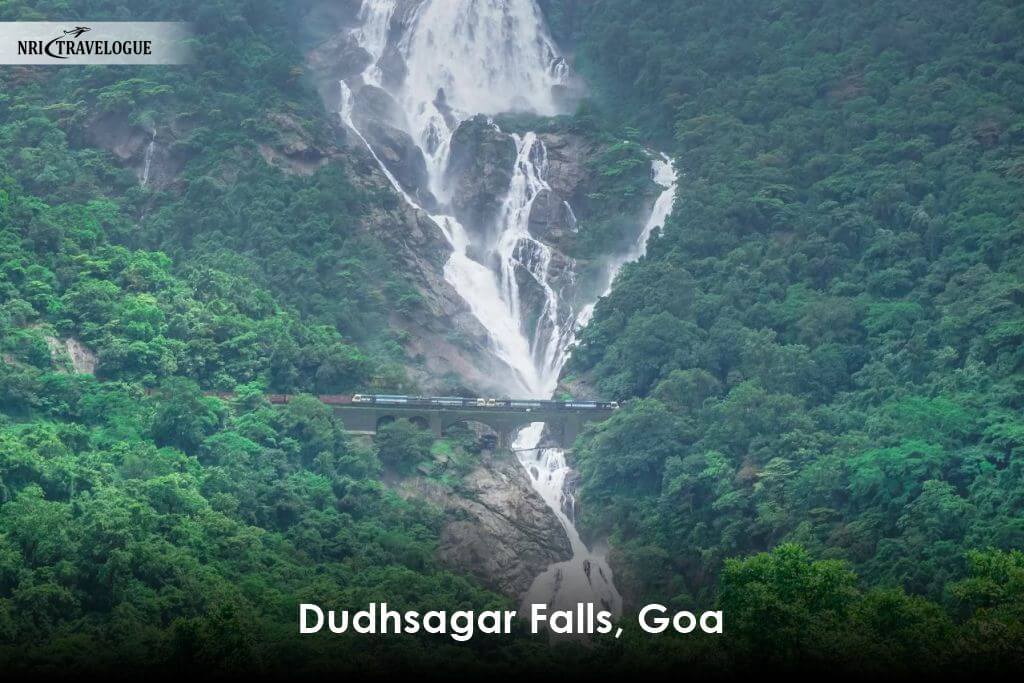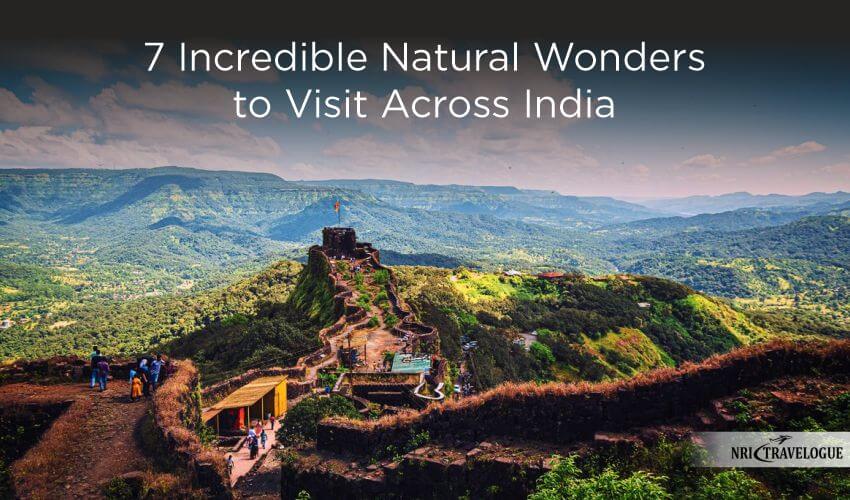Some of the world’s most distinctive and incredible natural wonders can be found in India, a country known for its ravishing natural diversity. India’s geography is as diverse as its culture, ranging from the lush northeast to the untamed western deserts.
The natural wonders in India mesmerize you! Whether it’s glistening salt deserts under a full moon, magical illuminating lights in the mangroves, or serene waterfalls amid lush forests, everything has a tale to tell.
India’s natural wonders provide a variety of experiences, from peaceful natural retreats to exhilarating thrills. The Floating Island on Loktak Lake in Manipur, the Aleya Ghost Lights of the Sundarbans, the Sparkling Salt Deserts of Kutch, the Meteoric Lonar Lake in Maharashtra, the Living Root Bridges of Meghalaya, the Dudhsagar Falls in Goa, and Magnetic Hill in Leh are the seven amazing natural wonders of India, that Team NRI has chosen just for you!
These tourist places are a must-visit for anyone looking to experience India’s natural beauty closely.
1. Dudhsagar Falls, Goa
The magnificent four-tiered Dudhsagar Falls is situated on the border between Goa and Karnataka. The falls, which plunge from 310 meters above sea level, are a marvellous sight, particularly when they are flowing freely during the monsoon season. “Dudhsagar” means “Sea of Milk,” a reference to the frothy white look of the water that is falling with great speed. The falls’ natural attractiveness is increased by the verdant woodlands that encircle them.

Tourists can trek along the Bhagwan Mahavir Wildlife Sanctuary, which provides an exotic view of rare plants and animals. Do not forget to try a picturesque train journey over the Konkan Railway that passes by the falls. Indeed. it is an exhilarating experience. only for the daring. Seeing the cascade at its height is guaranteed while visiting Dudhsagar Falls during the monsoon season.
2. Floating Island on Loktak Lake, Manipur
The largest freshwater lake in northeastern India, Loktak Lake, is well-known for its unusual floating islands, or “phumdis.” The sight of these masses of organic materials, flora, and dirt floating on the lake’s surface is captivating. The most famous phumdi is Keibul Lamjao National Park, which is home to the endangered Sangai deer and is the only floating national park in the world.

Boat cruises around the lake allow visitors to enjoy the tranquil beauty of the surroundings. Many migratory species visit the lake. So, bird viewing a popular hobby. Winter is the ideal season to visit because of the beautiful weather and clear views of the floating islands.
3. Magnetic Hill, Leh
Curious tourists are drawn to Magnetic Hill, a gravity-defying phenomenon on the Leh-Kargil-Baltic National Highway. When parked at a specific location, the hill gives the impression of a magnetic force, pulling cars uphill. Even if science says it’s an optical illusion brought on by the surroundings, it’s still an amazing sight.

To see the effect for themselves, tourists frequently drive or ride bicycles to the location. The hill serves as a starting point for visits to other nearby sights, including the picturesque Zanskar Range and the Indus Valley. May to September are the best months to visit for tourists because of Leh’s perfect weather for outdoor exploration.
4. Aleya Ghost Lights, Sundarbans
The Sundarbans, a UNESCO World Heritage site, are home to the enigmatic Aleya Ghost Lights, a natural phenomena. Over the marshes, these luminous spheres of light arise out of nowhere, occasionally misguiding fishermen.

Scientists speculate that the ionization of methane gas from decomposing organic waste is the cause of the lights, but the local stories are much more sinister. The already fascinating Sundarbans, which are home to the Bengal tiger and other species of fauna become mysterious because of these lights.
Tourists can plan to take a boat safari and get the opportunity to see these odd lights at dusk through the mangrove swamps.
5. Sparkling Salt Deserts of Kutch, Gujarat
The Great Rann of Kutch is an 8,000 square kilometer expanse of white salt desert in Gujarat. One of the world’s largest salt deserts, this picturesque environment is especially beautiful during a full moon. Folk performances, regional crafts, and adventurous activities are all part of the Rann Utsav, a cultural event that takes place every winter in the Rann.

The neighboring Kala Dungar (Black Hill), which provides expansive vistas of the infinite white desert, is another place for visitors to explore. The ideal time for tourists is between November and February, when the Rann Utsav is in full swing and the weather is milder.
6. The Meteoric Lonar Lake, Maharashtra
Located in the Buldhana district of Maharashtra, Lonar Lake is a unique saltwater lake that was created by a meteor strike approximately 50,000 years ago. With its breathtaking greenish-blue lake surrounded by lush forest, this uncommon geological occurrence draws both geologists and tourists.

Unique microorganisms can be found in the lake’s alkaline and saline water, which is also home to a variety of plants and animals. Trekking along the rim of the crater, exploring historic temples, and observing migratory birds that frequent the lake are all great options for tourists. October through March are the ideal months to visit Lonar Lake because of the excellent weather that is ideal for outdoor activities.
7. Living Root Bridges, Meghalaya
The Khasi and Jaintia people worked for generations to create the remarkable bioengineered Living Root Bridges of Meghalaya. To create sturdy, living constructions that can bear the weight of multiple people, rubber tree roots are guided to grow across rivers and streams to form these bridges. Cherrapunji and Nongriat are home to the most well-known bridges, including the magnificent double-decker root bridge.

Trekking to these bridges provides a unique experience of Meghalaya’s natural splendor to tourists as it passes through beautiful valleys, waterfalls, and lush green woods. Try to avoid the intense monsoon rains and plan a visit during the milder months of October to April.
Wrapping Up
These natural wonders are must-see places in India for any nature lover since they provide an incredible window into India’s varied natural beauty.
These locations encourage tourists to discover the wonders of nature, from the ethereal charm of the Aleya Ghost Lights to the surreal splendor of the Rann of Kutch. These seven wonders guarantee life-changing experiences for adventurers, nature lovers, and inquisitive tourists alike.
The best time to visit Dudhsagar Falls is during the monsoon season (June to September)
The best way to explore Loktak Lake is through boat rides. This way tourists can see the unique floating islands and wildlife.
The Magnetic Hill illusion is a result of the optical illusion created by the surrounding landscape. This makes a downhill slope appear uphill.
The Aleya Ghost Lights are not dangerous. However, local fishermen advise caution when navigating the marshes where they appear.
The Living Root Bridges are unique because they are made from living tree roots guided to grow over time.









